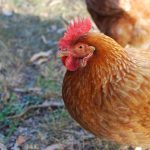Chickens are social creatures that thrive in structured environments. They possess natural instincts to forage, dust bathe, and roost at night. Understanding these behaviors is essential for creating a safe and comfortable habitat.
Chickens establish a hierarchical pecking order within their flock, which can lead to aggression if not properly managed. Providing adequate space is crucial to allow chickens to establish their hierarchy without overcrowding, which can cause stress and aggressive behavior. As prey animals, chickens are easily startled by loud noises and sudden movements.
A calm and quiet environment helps reduce stress and keeps them at ease. Chickens are also naturally curious and exploratory, often attempting to escape their enclosures in search of new food sources or to satisfy their inquisitive nature. This behavior necessitates the design of secure coops and runs that prevent escape while still allowing for natural behaviors.
By comprehending chicken behavior, caretakers can create an environment that meets both the physical and psychological needs of these birds, resulting in healthier and more content animals. This understanding is crucial for maintaining a well-adjusted and thriving flock.
Table of Contents
- 1 Creating a secure chicken coop
- 2 Installing a barrier on top of the fence
- 3 Providing enrichment and distractions for the chickens
- 4 Trimming the wings of the chickens
- 5 Training the chickens to stay within the designated area
- 6 Seeking professional advice for stubborn chickens
- 7 FAQs
- 7.1 What are some ways to keep chickens from jumping the fence?
- 7.2 Is it safe to clip a chicken’s wings to prevent them from jumping the fence?
- 7.3 What type of barrier can be added to the top of the fence to prevent chickens from jumping over?
- 7.4 How can providing enough space and enrichment within the chicken coop discourage them from trying to escape?
Key Takeaways
- Chickens are social animals and exhibit natural behaviors such as scratching, dust bathing, and roosting.
- A secure chicken coop should have strong, predator-proof walls and a well-secured door to keep the chickens safe at night.
- Installing a barrier on top of the fence can prevent chickens from flying over and escaping the designated area.
- Providing enrichment such as perches, dust baths, and hanging treats can keep chickens entertained and reduce stress.
- Trimming the wings of chickens can prevent them from flying over fences and escaping.
- Training chickens to stay within the designated area can be achieved through positive reinforcement and consistent boundaries.
- Seeking professional advice can be helpful for dealing with stubborn chickens or specific behavioral issues.
Creating a secure chicken coop
Construction and Maintenance
The coop should be well-constructed with sturdy materials and secure locks to prevent predators from gaining access. It’s important to regularly inspect the coop for any signs of wear and tear, such as holes or loose boards, and promptly repair them to maintain its security.
Design Considerations
The coop should be elevated off the ground to prevent predators from digging underneath it. The size of the coop is also important in providing enough space for the chickens to roost, nest, and move around comfortably. Overcrowding can lead to stress, aggression, and health issues, so it’s important to provide adequate space for the number of chickens in your flock.
Ventilation and Air Quality
The coop should also have proper ventilation to ensure good air quality and prevent the buildup of moisture, which can lead to respiratory issues in chickens.
By creating a secure chicken coop, you can provide a safe and comfortable environment for your chickens to thrive.
Installing a barrier on top of the fence

Installing a barrier on top of the fence is an effective way to prevent chickens from escaping their designated area. Chickens are known for their ability to fly short distances, so having a barrier on top of the fence will prevent them from flying over and escaping. The barrier can be made of wire mesh or netting that extends above the height of the fence to deter the chickens from attempting to fly over it.
It’s important to regularly inspect the barrier for any signs of damage or wear and tear, and promptly repair or replace it as needed. In addition to preventing escape, a barrier on top of the fence can also provide protection from predators such as hawks and other birds of prey. It’s important to ensure that the barrier is securely attached to the fence to prevent predators from gaining access to the chickens.
By installing a barrier on top of the fence, you can effectively prevent your chickens from escaping while also providing protection from potential predators.
Providing enrichment and distractions for the chickens
Providing enrichment and distractions for the chickens is important in keeping them mentally stimulated and preventing boredom. Chickens are intelligent animals that require mental stimulation to prevent behavioral issues such as feather pecking and aggression. Enrichment can include providing objects for them to peck at, such as hanging vegetables or a pecking block, as well as providing opportunities for them to dust bathe and forage for food.
Distractions such as mirrors or hanging treats can also provide entertainment for the chickens and prevent boredom. It’s important to regularly rotate and introduce new enrichment items to keep the chickens engaged and prevent habituation. Additionally, allowing the chickens access to a larger outdoor area where they can explore and forage can also provide enrichment and prevent boredom.
By providing enrichment and distractions for the chickens, you can keep them mentally stimulated and prevent behavioral issues.
Trimming the wings of the chickens
Trimming the wings of the chickens is an effective way to prevent them from flying over fences and escaping their designated area. Wing trimming involves carefully clipping the primary feathers on one wing to prevent the chicken from achieving lift when attempting to fly. It’s important to use sharp scissors or clippers and only trim a small portion of the feathers to avoid causing pain or injury to the chicken.
Wing trimming should be done with caution and ideally by someone with experience, such as a veterinarian or professional poultry handler. It’s important to note that wing trimming is a temporary solution and will need to be repeated as new feathers grow in. Additionally, wing trimming should be done in conjunction with other preventative measures, such as installing a barrier on top of the fence, to ensure that the chickens are unable to escape.
By trimming the wings of the chickens, you can effectively prevent them from flying over fences while still allowing them to exhibit their natural behaviors within their designated area.
Training the chickens to stay within the designated area

Understanding the Training Process
By consistently rewarding the chickens for staying within their designated area, they will learn that remaining within the boundaries is associated with positive outcomes.
Key Factors for Successful Training
It’s important to be patient and consistent with training, as it may take time for the chickens to learn and understand what is expected of them. Additionally, providing visual cues such as flags or markers can help define the boundaries of their designated area and reinforce where they should stay.
Benefits of Training Chickens
By training the chickens to stay within their designated area, you can effectively prevent them from escaping while still allowing them some freedom to roam within their defined space.
Seeking professional advice for stubborn chickens
In some cases, chickens may be particularly stubborn or difficult to train, especially if they have developed a habit of escaping their designated area. In these instances, seeking professional advice from a veterinarian or experienced poultry handler may be necessary. A professional can provide guidance on effective training techniques and offer solutions tailored to your specific situation.
Additionally, a professional can assess your chicken coop and run for any potential weaknesses or areas where improvements can be made to prevent escape. They may also provide recommendations for managing aggressive behavior or addressing any underlying issues that may be contributing to escape attempts. By seeking professional advice for stubborn chickens, you can gain valuable insights and support in effectively managing their behavior and preventing escape.
If you’re struggling to keep your chickens from jumping the fence, you may want to consider building a chicken coop trampoline. This innovative solution is discussed in more detail in a related article on Poultry Wizard’s website. Check out this article for more information on how to keep your chickens safely contained.
FAQs
What are some ways to keep chickens from jumping the fence?
Some ways to keep chickens from jumping the fence include clipping their wings, adding a barrier to the top of the fence, and providing enough space and enrichment within the chicken coop to discourage them from trying to escape.
Is it safe to clip a chicken’s wings to prevent them from jumping the fence?
Yes, it is safe to clip a chicken’s wings if done properly. It is a common practice to prevent chickens from flying over fences and escaping their enclosures. It is important to research and follow proper wing clipping techniques to ensure the chicken’s safety.
What type of barrier can be added to the top of the fence to prevent chickens from jumping over?
A barrier such as chicken wire, netting, or hardware cloth can be added to the top of the fence to prevent chickens from jumping over. This barrier should be securely attached to the top of the fence to prevent any gaps or openings that the chickens could exploit.
How can providing enough space and enrichment within the chicken coop discourage them from trying to escape?
Chickens are less likely to try to escape if they have enough space to roam and engage in natural behaviors within their coop. Providing enrichment such as perches, dust baths, and toys can also keep them occupied and less inclined to attempt to jump the fence.
Meet Walter, the feathered-friend fanatic of Florida! Nestled in the sunshine state, Walter struts through life with his feathered companions, clucking his way to happiness. With a coop that’s fancier than a five-star hotel, he’s the Don Juan of the chicken world. When he’s not teaching his hens to do the cha-cha, you’ll find him in a heated debate with his prized rooster, Sir Clucks-a-Lot. Walter’s poultry passion is no yolk; he’s the sunny-side-up guy you never knew you needed in your flock of friends!







